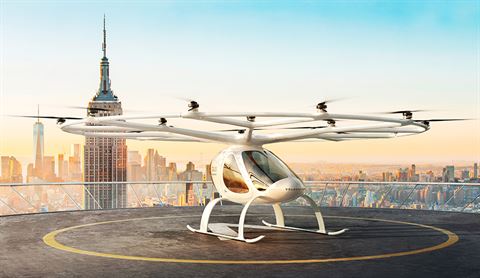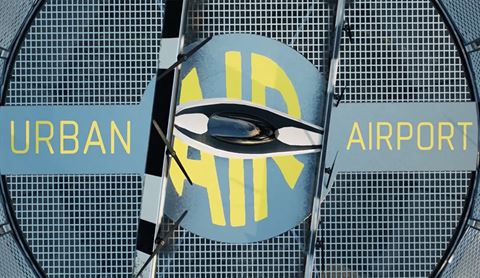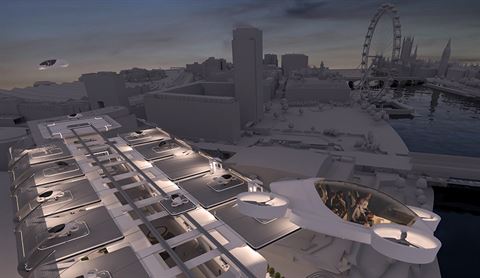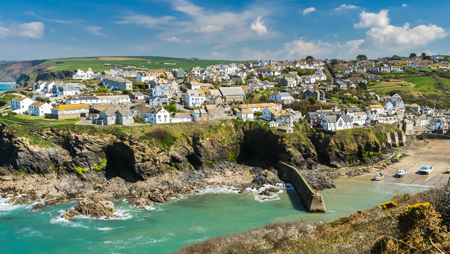FUTURE OF FLIGHT • November 2020
Vertiports: what are they and when can we expect them?
Imagine being able to leapfrog urban road congestion or hop from the city centre to the airport in a matter of minutes… Aero-industry journalist Paul Sillers says that the time for imagining may be nearing its end. In this month’s Future of Flight column, he sits down with the UK-based innovators bringing flying taxi ‘vertiports’ to market
Dozens of VTOLs (vertical take-off and landing aircraft) are at various stages of development – their manufacturers hoping to grab a slice of the nascent, but potentially lucrative, flying taxi market. Hyundai forecasts the air mobility market will be worth nearly $1.5trn over the next 20 years.
However, to get urban aerial mobility (UAM) off the ground, VTOLs have to be proven to be safe and reliable, air traffic management has to be adapted to accommodate them, the public will need to accept this new mode of transport – and it will have to be affordable.
And there’s another major hurdle: infrastructure for landing, recharging and taking off with fare-paying passengers needs to be in place. Cue vertiports. These are the vital terrestrial parts of the puzzle that are already taking shape in the form of micro-scale airports that can be deployed in urban locales and major transport hubs.
First mover advantage
In October last year, the world’s first air taxi vertiport prototype was unveiled at Singapore’s Float at Marina Bay during the Intelligent Transport Systems World Congress. The ‘VoloPort’ is the progeny of an alliance between air taxi manufacturer Volocopter and UK-based vertiport developer, owner and operator Skyports.
Uber has publicly declared that it aims to be operational with air taxis by 2023
“A number of cities are showing significant interest in vertiports,” says Duncan Walker, CEO of Skyports. “We’re working very closely with the Singaporean authorities, where we did our proof of concept, and there’s real momentum there – they’re very good early adopters of technology.”
Skyports is working with a dozen or so other megacities around the world – aiming for that first mover position in terms of commercial air taxi deployment – notably in Los Angeles, where Uber has publicly declared that it aims to be operational with air taxis by 2023.
Walker’s strategy for vertiport deployment includes joining the dots between urban business centres and the major air travel hubs, emphasising that “airports will be a really important part of the overall network, as clearly there’s a lot of traffic congestion between airports and downtown.”

Operations are to be managed from ‘Volo-hubs’, comprising an exterior landing pad and an adjacent enclosure where passengers can alight. Photo: Volocopter
Skyports is already involved with an initiative with Groupe ADP, RATP Groupe and Volocopter to deliver a showcase urban aerial network for the 2024 Paris Olympics, which Walker says will be “a really good catalyst to start the air taxi market”.
What will vertiports look like?
In terms of defining Skyport’s vertiport architecture, on the air side, regulatory and safety factors drive the design, just as they do at an airport – including how far apart the VTOLs have to be, how far the landing area is from the gate and how to safely recharge.
As for the land side of the vertiports, Walker says that other than some large showcase sites, which “will be figureheads for the industry”, Skyports’ focus is on defining a set of design standards for its vertiports to make them economical to install at scale.
“This industry will scale quickly if the price point is at a level that is meaningful for lots of people, rather than being a very expensive form of transportation”
“With a new industry, there’s a real balance between incurring large amounts of capital costs for infrastructure, while not having the visibility of the revenue streams yet,” says the Skyports boss, as the company forges ahead with providing relatively low cost, rapidly deployable infrastructure to enable this new market to gain traction.
“This industry will scale quickly if the price point is at a level that is meaningful for lots of people, rather than being a very expensive form of transportation, and it’s beholden on everybody in the industry to achieve those goals, including infrastructure providers.”
Infrastructure as a service
Elsewhere, in a collaboration between Urban-Air Port Ltd (a subsidiary of small., a group of UK-based urban deeptech companies focusing on future mobility) and air taxi manufacturer Hyundai Air Mobility (a division of Hyundai Motor Group), things are gathering pace.
In July, the two entities forged a partnership to explore purpose-built, multifunctional and scalable UAM infrastructure, with Hyundai investing $1.5bn over the next five years to create an air vehicle plus the supporting mobility ecosystem for aerial taxi services.
“There’s often a strong focus on the vehicles but, without coordination and investment in other parts of the ecosystem, UAM is just a flying science project,” says Pamela Cohn, COO of Hyundai Air Mobility. “Infrastructure is one of the crucial areas of the broader ecosystem that will bring aerial mobility to communities around the world.”

Urban-Air Port will provide the physical landing and take-off, charging, maintenance and passenger processing tech (pictured above), as well as the digital infrastructure to transport people and logistics via VTOLs.
“We have certified infrastructure, and our urban air ports have their various sizes. It’s very important to provide the entire package, so we’re providing infrastructure as a service to enable UAM as a one stop solution – that’s our business model,” says Ricky Sandhu, CEO of Urban-Air Port.
The company’s solutions are modular, rapidly deployable, transportable and scalable, says Sandhu, adding that his company will “help clients figure out what capacity is required, what the fleet mix looks like, what the demand is and what turnaround times will be.”
Vertiport deployments in the UK
Sandhu says expressions of interest have come from a number of cities across the globe, as well as from two UK airports that “are interested in integrating air taxis with their core infrastructure”, adding that urban air ports (as he prefers to call vertiports) can “gain an aviation foothold in places previously considered unattainable. Whereas people once thought that this kind of infrastructure would not be able to be accommodated, because of our compact form, and the modular nature of it, it now means it can be deployed in the locations where zero-emission mobility is actually needed.”
By integrating charging and battery swapping capability for air taxis into their design, other forms of zero-emission vehicles can be charged
The first deployment will be in Coventry in the UK, where Hyundai Air Mobility and Urban-Air Port will roll out a full-scale prototype vertiport for live electric VTOL demonstrations as part of the UK City of Culture 2021 and the 2022 Commonwealth Games events.
Sandhu says that by integrating charging and battery swapping capability for air taxis into their design, other forms of zero-emission vehicles can be charged: “It’s going to be a hub for all kinds of electric mobility, not just VTOLs, but also drones, electric bikes and also electric cars — that’s what we’re going to be demonstrating in Coventry.”
Integrating with the bigger picture
From the perspective of London-based airport architecture practice Pascall+Watson, the provision of a public air taxi service will have the greatest benefit when integrated with existing transport hubs such as rail stations, airports and major transport interchanges. The firm is currently developing an ‘interchange plaza’ to provide a focal point for all methods of sustainable public transport, and has been looking at how its concept could work at some of London’s major rail termini.
“Air taxis and vertiports need to be part of a bigger infrastructural strategy, and architecturally we’ve looked at three key issues. We’ve looked at existing city structure, at transport architecture typologies and at how vertiports could be complementary to the existing transport infrastructure,” says Pascall+Watson director Julian Carlson.

A vision of the future: London, but not as you know it. Rendering: Pascall+Watson
“We have such great historic infrastructure design in London, through rail, river, road and aviation traffic, and we really need to harmonise those more.”
Alternative concepts
In another concept, Pascall+Watson has come up with a ‘verti-port’ (as in a water-based port) that can be installed on a floating platform, leveraging the central proximity of rivers within major cities.
The water-borne approach enables remote manufacture, with the final assembly of the vertiport simply being floated and moored into place, say the architects, who see quayside locations offering “potential to harness tidal, wind and solar power generation to make the facility fully autonomous”.
Another conceptual approach from Pascall+Watson is the introduction of ‘pop-up airfields’ for out-of-city VTOL locations, whereby existing but under-utilised infrastructure such as roof space, car parks, heliports or disused airfields could be repurposed to take the strain off surface transport in and out of cities.
As for the passenger experience, Carlson says the company is working to “make sure that we create a passenger experience that has a simplified interface and a seamless process. People want a bit of time when they get to where they’re going to. It’s like when you go to the train station, where you have other things that you do when you get there – for example, you fancy a coffee and a sandwich. The quality of the travel experience at a vertiport needs to be as much about that as it is about getting on board a very exciting vehicle.”
This article has been tagged BA, Technology
More from previous issues

Five epic drives: Jessica Hawkins
What drives changed you? That’s the question we ask the 007 stunt woman and race-track triumph

The best of British Airways news
Do I need to wear a mask on board? Can I use airport lounges, even if I’m not an Executive Club Member? We have the answers

The Members’ guide to UK staycations
You’ve got weekends to fill, holiday to take and a whole island at your feet: join your fellow Members on their tours of beautiful Blighty

The Club’s favourite winter sun escapes
A place in the sun: we check in to the hottest hotels that come with their own slice of paradise
